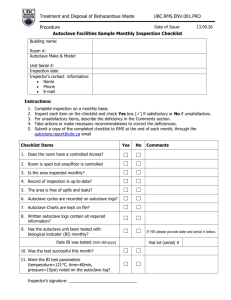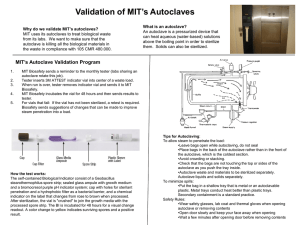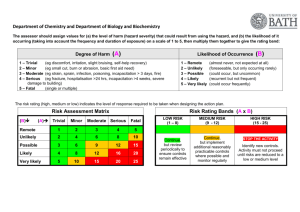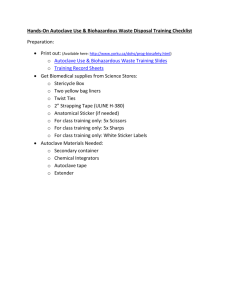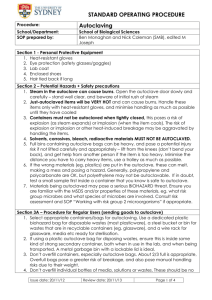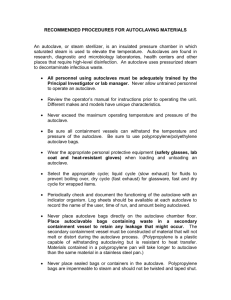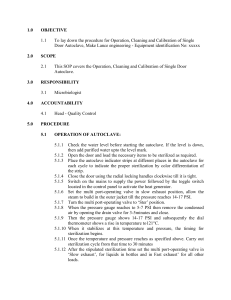STANDARD OPERATI NG PROCEDURE FOR AUTOCLAVE
advertisement
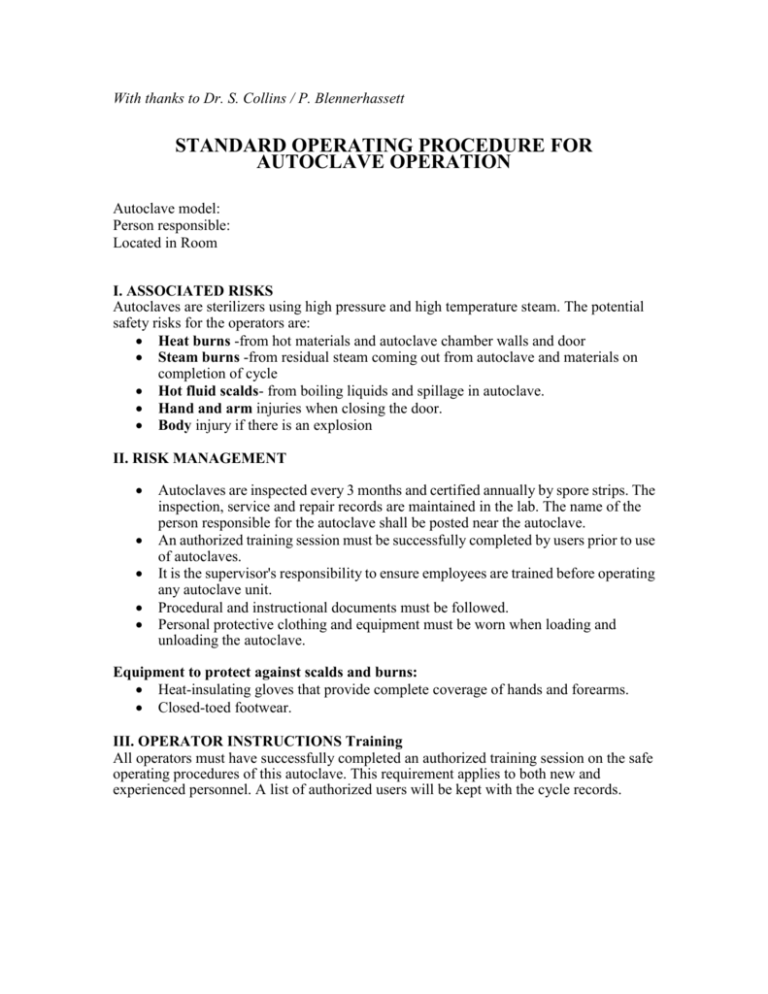
With thanks to Dr. S. Collins / P. Blennerhassett STANDARD OPERATING PROCEDURE FOR AUTOCLAVE OPERATION Autoclave model: Person responsible: Located in Room I. ASSOCIATED RISKS Autoclaves are sterilizers using high pressure and high temperature steam. The potential safety risks for the operators are: Heat burns -from hot materials and autoclave chamber walls and door Steam burns -from residual steam coming out from autoclave and materials on completion of cycle Hot fluid scalds- from boiling liquids and spillage in autoclave. Hand and arm injuries when closing the door. Body injury if there is an explosion II. RISK MANAGEMENT Autoclaves are inspected every 3 months and certified annually by spore strips. The inspection, service and repair records are maintained in the lab. The name of the person responsible for the autoclave shall be posted near the autoclave. An authorized training session must be successfully completed by users prior to use of autoclaves. It is the supervisor's responsibility to ensure employees are trained before operating any autoclave unit. Procedural and instructional documents must be followed. Personal protective clothing and equipment must be worn when loading and unloading the autoclave. Equipment to protect against scalds and burns: Heat-insulating gloves that provide complete coverage of hands and forearms. Closed-toed footwear. III. OPERATOR INSTRUCTIONS Training All operators must have successfully completed an authorized training session on the safe operating procedures of this autoclave. This requirement applies to both new and experienced personnel. A list of authorized users will be kept with the cycle records. Material Preparation Ensure that the material is able to be autoclaved samples containing solvents or substances that may emit toxic fumes should not be autoclaved. Glassware must be inspected for cracks prior to autoclaving. Prepare and package material suitably: Loose dry materials must be wrapped or bagged in steam-penetrable paper or loosely covered with aluminum foil. Wrapping too tightly will impede steam penetration, decreasing efficiency of the process. All containers must be covered by a loosened lid or steam-penetrable bung. Containers of liquid must be a maximum of 2/3 full, with lids loosened. Glassware must be heat-resistant borosilicate. Plastics must be heat-resistant eg: polycarbonate (PC), PTFE ("Teflon") and most polypropylene (PP) items. Sharps must be in a designated 'Sharps' container. Items or baskets must be tagged with autoclave tape to verify sterilization. Loosen all lids to prevent pressure buildup. Add water to containers as appropriate. Place items in containers to secure and contain spills: Items should be placed in a stainless steel or autoclavable plastic container for their stability and ease of handling. Place containers of liquid, bags of agar plates, or other materials that may boil over or leak, into a secondary pan in the autoclave. The pan must be large enough to contain a total spill of the contents. Bags must not be tightly sealed as steam cannot penetrate. Biohazard materials must be labelled as such and secured in containment vessels or autoclavable bags and processed as soon as possible according to requirements for the handling of infectious or biohazard materials. Loading Autoclave Wear heat-insulating gloves, and closed toed shoes. Place material in autoclave. Do not mix incompatible materials. Do not overload; leave sufficient room for steam circulation. If necessary, place the container on its side to maximize steam penetration and avoid entrapment of air. Close and latch door firmly. Operating Autoclave Check to be sure that the water reservoir is filled (approximately 1” from top), and if not, fill with distilled water. Choose appropriate cycle ( e.g. fluid, dry etc) for the material. Set appropriate temperature for the cycle. Turn the autoclave to FILL and wait until the water in the bottom of the autoclave covers the fill plate. Turn the autoclave to STERILIZE and load autoclave Close and lock door A steam cycle is approximately 40 minutes if the autoclave is cold and approximately 20 minutes if it is already warmed from a previous steam cycle. When cycle is complete, turn autoclave to VENT and remain there until pressure drops. The heat stays on during the venting and without the steam plastics will melt. Turn the autoclave to POWER OFF. Do not attempt to open the door while autoclave is operating. The manuals for operation of the autoclave are located on the wall behind the autoclave. Unloading Autoclave Wear heat-insulating gloves and closed toed shoes. Ensure that the pressure of the chamber is '8' before opening the door. Wear gloves and stand back from the door as a precaution, carefully crack door open no more than 1 inch (2.5 cm) to release residual steam and allow pressure within liquids and containers to normalize. Allow sterilized material to stand for 10 minutes in the chamber. This will allow steam to clear and trapped air to escape from hot liquids, reducing risk to operator. Do not agitate containers of super-heated liquids or remove caps before unloading. After removal from the autoclave, place hot items in an area which clearly indicates the items are 'hot' until the items cool to room temperature. Push door closed. Autoclave Log Entries must be placed in the log books each time the autoclave is used. These records are used for maintenance/service schedules and reporting of incidents, accidents and/or faults The cycle records for the autoclaves will be kept on top of the autoclave Entries should include: operator's name, date, time and duration. Maintenance and repair No person shall operate the autoclave unless the autoclave is in good repair Users are not to make repairs Report possible malfunctions to ___________________. Repairs are performed by Bert Visheau ext 22213. IV. CONTINGENCY PLAN Equipment malfunction If the autoclave does not operate exactly as expected, do not attempt to fix the problem. A notice shall be placed on the autoclave indicating that it is not to be used until the problem is diagnosed and corrected. Record the problem in the autoclave log book. Contact ______________or Bert (22213) to report the problem. Repair of autoclaves shall be performed by qualified persons only. Incident response All incidents are to be reported to __________________ If any injury occurs seek first aid or, if necessary, seek medical assistance by dialing emergency number for your area. If clothing is soaked in hot water/steam, remove clothing and cool the injured part in cool water. Place a notice on the autoclave indicating that it is not to be used until the cause of the incident is determined, procedures enacted to prevent future incidents, and the autoclave is deemed safe for operation. A list of people trained to provide first aid will be posted in the lab. Spill clean-up Spills may occur from a boil over or breakage of containers. No operation of the autoclave is allowed until the spill is cleaned up. The operator is responsible for cleanup of spills. Contain the spilled material using paper towel, to absorb or contain the spill. Wait until the autoclave and materials have cooled to room temperature. Review the MSDS, if appropriate, to determine the protective equipment, spill cleanup and disposal protocols that are necessary. Clean the equipment and work area in order to collect and remove all spilled materials. Dispose of the waste following the protocol appropriate for the material. If materials have been intermingled, follow the cleanup and disposal protocol for the most hazardous component of the mixture. Cracked glassware must be disposed of properly in the "Broken Glass" disposal pail. Record the spill and cleanup procedure in the autoclave log book. FHSc. Safety Office November 2007


